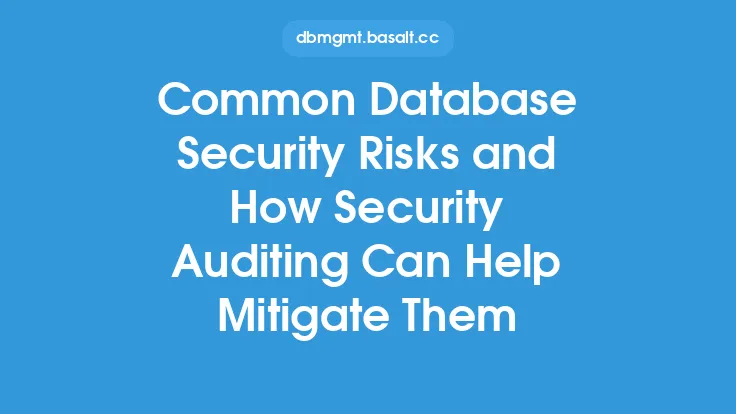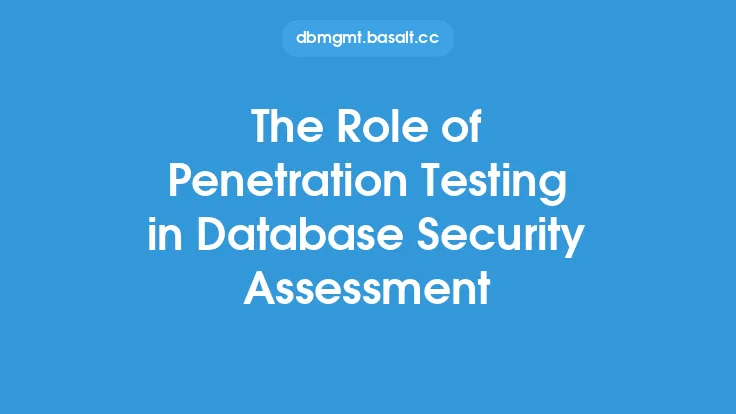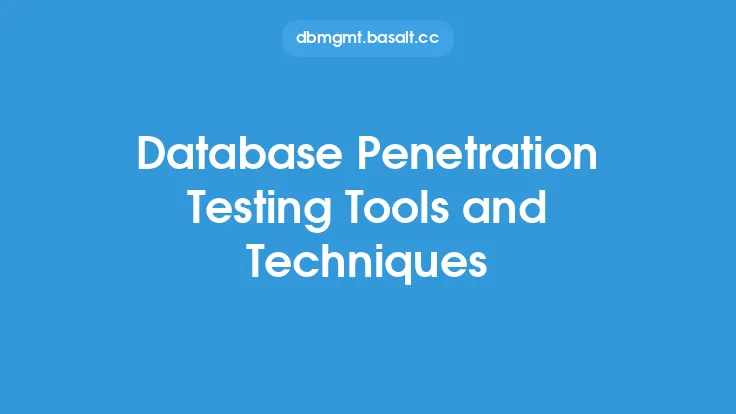Penetration testing is a crucial aspect of database security, as it helps identify vulnerabilities and weaknesses in the database system that could be exploited by attackers. By simulating real-world attacks, penetration testers can assess the database's defenses and provide recommendations for improvement. In the context of database security, penetration testing is essential for mitigating risks and ensuring the confidentiality, integrity, and availability of sensitive data.
Introduction to Penetration Testing in Database Security
Penetration testing, also known as pen testing or ethical hacking, is a systematic process of evaluating the security of a database system by simulating cyber attacks. The goal of penetration testing is to identify vulnerabilities, weaknesses, and potential entry points that an attacker could exploit to gain unauthorized access to the database. By conducting regular penetration tests, organizations can proactively identify and address security risks, reducing the likelihood of a successful attack.
Types of Penetration Tests for Database Security
There are several types of penetration tests that can be conducted to evaluate database security, including:
- Network-based penetration tests: These tests focus on identifying vulnerabilities in the network infrastructure that could be used to gain access to the database.
- Application-based penetration tests: These tests focus on identifying vulnerabilities in the database application itself, such as SQL injection or cross-site scripting (XSS) vulnerabilities.
- Configuration-based penetration tests: These tests focus on identifying vulnerabilities in the database configuration, such as weak passwords or misconfigured access controls.
- Physical penetration tests: These tests focus on identifying vulnerabilities in the physical security of the database, such as unauthorized access to the data center or server room.
Penetration Testing Methodologies for Database Security
Penetration testing methodologies for database security typically involve a combination of automated and manual testing techniques. Automated testing tools, such as vulnerability scanners and penetration testing frameworks, can be used to identify potential vulnerabilities and weaknesses in the database system. Manual testing techniques, such as social engineering and exploit development, can be used to simulate real-world attacks and evaluate the effectiveness of the database's defenses.
Database Security Risks and Vulnerabilities
Databases are vulnerable to a wide range of security risks and vulnerabilities, including:
- SQL injection attacks: These attacks involve injecting malicious SQL code into the database in order to extract or modify sensitive data.
- Cross-site scripting (XSS) attacks: These attacks involve injecting malicious code into the database application in order to steal user credentials or take control of user sessions.
- Weak passwords and authentication: Weak passwords and inadequate authentication mechanisms can provide an easy entry point for attackers.
- Misconfigured access controls: Misconfigured access controls can provide unauthorized access to sensitive data or database functionality.
- Data encryption and key management: Inadequate data encryption and key management practices can compromise the confidentiality and integrity of sensitive data.
Mitigating Database Security Risks and Vulnerabilities
To mitigate database security risks and vulnerabilities, organizations can implement a range of security controls and countermeasures, including:
- Implementing robust access controls: Implementing robust access controls, such as multi-factor authentication and role-based access control, can help prevent unauthorized access to the database.
- Encrypting sensitive data: Encrypting sensitive data, both in transit and at rest, can help protect against unauthorized access or disclosure.
- Regularly updating and patching software: Regularly updating and patching software can help prevent exploitation of known vulnerabilities.
- Implementing intrusion detection and prevention systems: Implementing intrusion detection and prevention systems can help detect and prevent malicious activity.
- Conducting regular security audits and penetration tests: Conducting regular security audits and penetration tests can help identify and address security risks and vulnerabilities.
Best Practices for Penetration Testing in Database Security
To get the most out of penetration testing in database security, organizations should follow best practices, including:
- Defining clear testing objectives and scope: Defining clear testing objectives and scope can help ensure that the penetration test is focused and effective.
- Using experienced and skilled testers: Using experienced and skilled testers can help ensure that the penetration test is conducted thoroughly and effectively.
- Testing in a controlled environment: Testing in a controlled environment can help minimize the risk of disruption or damage to the database system.
- Providing detailed reporting and recommendations: Providing detailed reporting and recommendations can help organizations prioritize and address identified security risks and vulnerabilities.
Conclusion
Penetration testing is a critical component of database security, as it helps identify vulnerabilities and weaknesses in the database system that could be exploited by attackers. By conducting regular penetration tests and implementing robust security controls and countermeasures, organizations can mitigate database security risks and vulnerabilities, ensuring the confidentiality, integrity, and availability of sensitive data.





